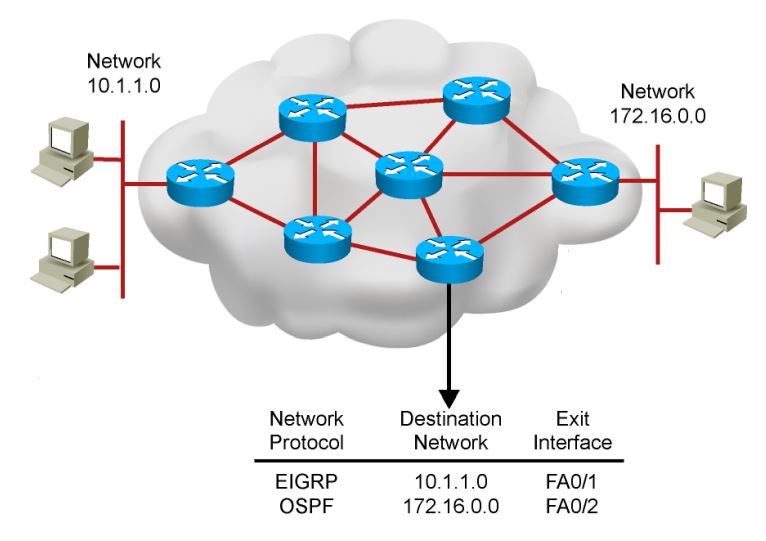Before we start talking about Routing Protocol first we must know what Routing means? So here are some points that explain what routing really is:
What is Routing?
- The process of transferring data from one local area network to another local area network with the help of Layer 3 devices (Router)
- The routed protocol enables to forward packets from one router to another Example – IP
- Routing protocol sends and receives routing information packets from one router to other routers
- Example -RIP, OSPF, EIGRP
- Routing protocols gather and share the routing information which is used to maintain and update the routing table.
- That routing information is in turn used to route a routed protocol to its final destination
What Is a Dynamic Routing Protocol?
Routing protocols are used between routers to determine paths to remote networks and maintain those networks in the routing tables. After the path is determined, a router can route a routed protocol to the learned networks.

Dynamic routes are routes learned via routing protocols. Routing protocols are configured on routers with the purpose of exchanging routing information. There are many benefits of using routing protocols in your network, such as:
- unlike static routing, you don’t need to manually configure every route on each router in the network. You just need to configure the networks to be advertised on a router directly connected to them.
- if a link fails and the network topology changes, routers can advertise that some routes have failed and picked a new route to that network.
Routing Categories:
- Autonomous System
- EGP
- IGP
To know more about Routing Categories click here.
Types of routing protocols
There are two types of routing protocols:
- Distance vector (RIP, IGRP)
- Link-state (OSPF, IS-IS)
Cisco has created its own routing protocol – EIGRP. EIGRP is considered to be an advanced distance vector protocol, although some materials erroneously state that EIGRP is a hybrid routing protocol, a combination of distance vector and link state.
All of the routing protocols mentioned above are interior routing protocols (IGP), which means that they are used to exchange routing information within one autonomous system. BGP (Border Gateway Protocol) is an example of an exterior routing protocol (EGP) that is used to exchange routing information between autonomous systems on the Internet.
1. Distance Vector Routing Protocol :
These protocols select the best path on the basis of hop counts to reach a destination network in a particular direction. Dynamic protocol like RIP is an example of a distance vector routing protocol. Hop count is each router that occurs in between the source and the destination network. The path with the least hop count will be chosen as the best path.
Features:
- Updates of the network are exchanged periodically.
- Updates (routing information) are always broadcast.
- Full routing tables are sent in updates.
- Routers always trust routing information received from neighbor routers. This is also known as routing on rumors.
Disadvantages:
- As the routing information is exchanged periodically, unnecessary traffic is generated which consumes available bandwidth.
- As full routing tables are exchanged, therefore it has security issues. If an authorized person enters the network, then the whole topology will be very easy to understand.
- Also, the broadcasting of the network periodically creates unnecessary traffic.
RIP and EIGRP are examples of distance vector routing protocols.
2. Link State Routing Protocol :
These protocols know more about Internetwork than any other distance vector routing protocol. These are also known as SPF (Shortest Path First) protocol. OSPF is an example of a link-state routing protocol.
Features:
- Hello, messages, also known as keep-alive messages are used for neighbor discovery and recovery.
- The concept of triggered updates is used i.e updates are triggered only when there is a topology change.
- Only that many updates are exchanged which is requested by the neighbor router.
Link state routing protocol maintains three tables namely:
- Neighbor table- the table which contains information about the neighbors of the router only, i.e, to which adjacency has been formed.
- Topology table- This table contains information about the whole topology i.e contains both best and backup routes to a particular advertised network.
- Routing table- This table contains all the best routes to the advertised network.
Advantages:
- As it maintains separate tables for both the best route and the backup routes ( whole topology) therefore it has more knowledge of the internetwork than any other distance vector routing protocol.
- The concept of triggered updates is used therefore no more unnecessary bandwidth consumption is seen like in distance vector routing protocol.
- Partial updates are triggered when there is a topology change, not a full update like distance vector routing protocol where the whole routing table is exchanged.
Shortest Path First algorithm is used to calculate the best route. OSPF and IS-IS are examples of link-state routing protocols.
Difference between distance vector and link-state routing protocols
The following table summarizes the differences:
| Distance Vector Routing | Link State Routing |
|---|---|
| The bandwidth required is less due to local sharing, small packets, and no flooding. | The bandwidth required is more due to flooding and sending of large link-state packets. |
| Based on local knowledge since it updates the table based on information from neighbors. | Based on global knowledge i.e. it has knowledge about the entire network. |
| Make use of Bellman Ford algorithm | Make use of Dijkastra’s algorithm |
| Traffic is less | Traffic is more |
| Converges slowly i.e. good news spread fast and bad news spreads slowly. | Converges faster. |
| Count to infinity problem. | No count to infinity problem. |
| Persistent looping problem i.e. loop will be there forever. | No persistent loops, only transient loops. |
| Practical implementation is RIP and EIGRP. | Practical implementation is OSPF and ISIS. |

Pingback: Routing Categories - Youngster Company